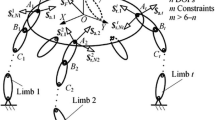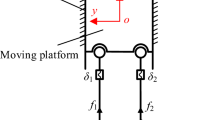Abstract
This paper reveals the relationship between the weighted Moore–Penrose generalized inverse and the force analysis of overconstrained parallel mechanisms (PMs), including redundantly actuated PMs and passive overconstrained PMs. The solution for the optimal distribution of the driving forces/torques of redundantly actuated PMs is derived in the form of a weighted Moore–Penrose inverse. Therefore, different force distributions can be achieved simply by changing the value of the weighted factor matrix in terms of different optimization goals, and this approach greatly improves computational efficiency in solving such problems. In addition, the explicit expression is deduced between the weighted Moore–Penrose generalized inverse and the constraint wrenches solution of general passive overconstrained PMs (in which each supporting limb may supply single or multiple constraint wrenches). In this expression, the weighted factor matrix is composed of the stiffness matrices of each limb’s constraint wrenches. As numerical examples, the driving forces/torques or the constraint forces/couples for two kinds of overconstrained PMs are solved directly by the weighted Moore–Penrose generalized inverse. The verification results show the correctness of the relationship obtained in this paper between the weighted Moore–Penrose generalized inverse and the force analysis of overconstrained PMs. Using the Moore–Penrose generalized inverse to solve the driving forces/torques or constraint forces/couples of overconstrained PMs provides solutions of a unified, simple form and improves computational efficiency.




Similar content being viewed by others
References
Dasgupta, B., Mruthyunjaya, T.S.: Force redundancy in parallel manipulators: theoretical and practical issues. Mech. Mach. Theory 33, 727–742 (1998)
Firmani, F., Podhorodeski, R.P.: Force-unconstrained poses for a redundantly-actuated planar parallel manipulator. Mech. Mach. Theory 39, 459–476 (2004)
Zhao, Y.J., Gao, F., Li, W.M., Liu, W., Zhao, X.C.: Development of a 6-DOF parallel seismic simulator with novel redundant actuation. Mechatronics 19, 422–427 (2009)
Zhao, Y.J., Gao, F.: Dynamic performance comparison of the 8PSS redundant parallel manipulator and its non-redundant counterpart—the 6PSS parallel manipulator. Mech. Mach. Theory 44, 991–1008 (2009)
Fang, Y.F., Tsai, L.W.: Enumeration of a class of overconstrained mechanisms using the theory of reciprocal screws. Mech. Mach. Theory 39, 1175–1187 (2004)
Huang, Z., Li, Q.C.: Type synthesis of symmetrical lower-mobility parallel mechanisms using the constraint-synthesis method. Int. J. Robot. Res. 22, 59–79 (2003)
Mavroidis, C., Roth, B.: Analysis of overconstrained mechanisms. J. Mech. Des., Trans. ASME 117, 69–74 (1995)
Merlet, J.-P.: Parallel Robots. Kluwer, London (2000)
Zheng, Y.F., Luh, J.Y.S.: Optimal load distribution for two industrial robots handling a single object. J. Dyn. Syst. Meas. Control, Trans. ASME 111, 232–237 (1989)
Gardner, J.F., Srinivasan, K., Waldron, K.J.: Solution for the force distribution problem in redundantly actuated closed kinematic chains. J. Dyn. Syst. Meas. Control, Trans. ASME 112, 523–526 (1990)
Nahon, M.A., Angeles, J.: Optimization of dynamic forces in mechanical hands. J. Mech. Transm. Autom. Des. 113, 167–173 (1991)
Gao, X.C., Song, S.M., Zheng, C.Q.: Generalized stiffness matrix method for force distribution of robotic systems with indeterminacy. J. Mech. Des., Trans. ASME 115, 585–591 (1993)
Huang, Z., Zhao, Y.S.: The accordance and optimization-distribution equations of the over-determinate inputs of walking machines. Mech. Mach. Theory 29, 327–332 (1994)
Zhao, Y.S., Lu, L., Zhao, T.S., Du, Y.H., Huang, Z.: Dynamic performance analysis of six-legged walking machines. Mech. Mach. Theory 35, 155–163 (2000)
Sapio, D.V., Srinivasa, N.: A methodology for controlling motion and constraint forces in holonomically constrained systems. Multibody Syst. Dyn. 33, 179–204 (2015)
Wang, G.R., Zheng, B.: The weighted generalized inverses of a partitioned matrix. Appl. Math. Comput. 155, 221–233 (2004)
Doty, K.L.: An essay on the application of weighted generalized inverses in robotics. In: 5th Conference on Recent Advances in Robotics, pp. 11–12 (1992)
Doty, K.L., Claudio, M., Claudio, B.: A theory of generalized inverses applied to robotics. Int. J. Robot. Res. 12, 1–19 (1993)
Vertechy, R., Parenti-Castelli, V.: Static and stiffness analyses of a class of over-constrained parallel manipulators with legs of type US and UPS. In: Proc. IEEE Int. Conf. Rob. Autom, pp. 561–567 (2007)
Wojtyra, M.: Joint reaction forces in multibody systems with redundant constraints. Multibody Syst. Dyn. 14, 23–46 (2005)
Wojtyra, M., Frączek, J.: Joint reactions in rigid or flexible body mechanisms with redundant constraints. Bull. Pol. Acad. Sci., Tech. Sci. 60, 617–626 (2012)
Huang, Z., Zhao, Y.S., Liu, J.F.: Kinetostatic analysis of 4-R(CRR) parallel manipulator with overconstraints via reciprocal-screw theory. Adv. Mech. Eng. 2010, 1–11 (2010)
Bi, Z.M., Kang, B.S.: An inverse dynamic model of over-constrained parallel kinematic machine based on Newton–Euler formulation. J. Dyn. Syst. Meas. Control, Trans. ASME 136, 1–9 (2014)
Gallardo, J., Rico, J.M., Frisoli, A., Checcacci, D., Bergamasco, M.: Dynamics of parallel manipulators by means of screw theory. Mech. Mach. Theory 38, 1113–1131 (2003)
Yao, J.T., Hou, Y.L., Chen, J., Lu, L., Zhao, Y.S.: Theoretical analysis and experiment research of a statically indeterminate pre-stressed six-axis force sensor. Sens. Actuators A, Phys. 150, 1–11 (2009)
Wang, Z.J., Yao, J.T., Xu, Y.D., Zhao, Y.S.: Hyperstatic analysis of a fully pre-stressed six-axis force/torque sensor. Mech. Mach. Theory 57, 84–94 (2012)
Kerr, D.R., Griffis, M., Sanger, D.J., Duffy, J.: Redundant grasps, redundant manipulators, and their dual relationship. J. Robot. Syst. 9, 973–1000 (1992)
Neto, M.A., Ambrósio, J.: Stabilization methods for the integration of DAE in the presence of redundant constraints. Multibody Syst. Dyn. 10, 81–105 (2003)
Xiong, Z.P., Qin, Y.Y.: Note on the weighted generalized inverse of the product of matrices. J. Comput. Appl. Math. 35, 469–474 (2011)
Sheng, X.P., Chen, G.L.: The generalized weighted Moore–Penrose inverse. J. Comput. Appl. Math. 25, 407–413 (2007)
Ben-Israel, A., Greville, T.N.E.: Generalized Inverse: Theory and Applications, Wiley-Interscience, New York (1974) (2nd edn. Springer, New York (2002))
Wu, J., Li, T.M., Xu, B.Q.: Force optimization of planar 2-DOF parallel manipulators with actuation redundancy considering deformation. Proc. Inst. Mech. Eng., Part C, J. Mech. Eng. Sci. 227, 1371–1377 (2013)
Zhao, Y.J., Gao, F.: Dynamic formulation and performance evaluation of the redundant parallel manipulator. Robot. Comput.-Integr. Manuf. 25, 770–781 (2009)
Xu, Y.D., Yao, J.T., Zhao, Y.S.: Inverse dynamics and internal forces of the redundantly actuated parallel manipulators. Mech. Mach. Theory 51, 172–184 (2012)
Xu, Y.D., Liu, W.L., Yao, J.T., Zhao, Y.S.: A method for force analysis of the overconstrained lower mobility parallel mechanism. Mech. Mach. Theory 88, 31–48 (2015)
Kong, X.W., Gosselin, C.M.: Type synthesis of 3-DOF translational parallel manipulators based on screw theory. J. Mech. Des., Trans. ASME 126, 83–92 (2004)
Xu, Y.D., Zhou, S.S., Yao, J.T., Zhao, Y.S.: Rotational axes analysis of the 2-RPU/SPR 2R1T parallel mechanism. Mech. Mach. Sci. 22, 113–121 (2014)
Dai, J.S., Ding, X.L.: Compliance analysis of a three-legged rigidly-connected platform device. J. Mech. Des., Trans. ASME 128, 755–764 (2006)
Pham, H.H., Chen, I.M.: Stiffness modeling of flexure parallel mechanism. Precis. Eng. 29, 467–478 (2005)
Gupta, D.K., Kaul, C.N.: Enclosing the square root of a positive definite symmetric matrix. Int. J. Comput. Math. 71, 105–115 (1999)
Hoskins, W.D., Walton, D.J.: Faster method of computing the square root of a matrix. IEEE Trans. Autom. Control AC-23, 494–495 (1978)
Franca, L.P.: Algorithm to compute the square root of \(3\times3\) positive definite matrix. Comput. Math. Appl. 18, 459–466 (1989)
Frommer, A., Hashemi, B., Sablik, T.: Computing enclosures for the inverse square root and the sign function of a matrix. Linear Algebra Appl. 456, 199–213 (2014)
Frommer, A., Hashemi, B.: Verified computation of square roots of a matrix. SIAM J. Matrix Anal. Appl. 31, 1279–1302 (2009)
Johnson, C.R., Okubo, K., Reams, R.: Uniqueness of matrix square roots and an application. Linear Algebra Appl. 323, 51–60 (2001)
Acknowledgements
This research was sponsored by the National Natural Science Foundation of China under Grant 51275439.
Author information
Authors and Affiliations
Corresponding author
Appendix: A method to calculate the square root and the inverse square root of a positive definite matrix
Appendix: A method to calculate the square root and the inverse square root of a positive definite matrix
Let \(\boldsymbol{A}\), \(\boldsymbol{B} \in \mathbb{C}^{n \times n}\), if \(\boldsymbol{B}^{2} = \boldsymbol{A}\), then \(\boldsymbol{B}\) is a square root of \(\boldsymbol{A}\), denoted by \(\boldsymbol{B} = \boldsymbol{A}^{\frac{1}{2}}\). If \(\boldsymbol{B}\) is a solution of the matrix equation \(\boldsymbol{AB}^{2} = \boldsymbol{I}\), then \(\boldsymbol{B}\) is an inverse square root of \(\boldsymbol{A}\), denoted by \(\boldsymbol{B} = \boldsymbol{A}^{ - \frac{1}{2}}\). There is a vast amount of literature focusing on the square root or the inverse square root of a matrix [40–45]. If \(\boldsymbol{A}\) is a nonsingular matrix, its square root and inverse square root always exist.
Particularly, if \(\boldsymbol{A}\) is a positive definite symmetric square matrix, then there exists a unique positive definite symmetric square root \(\boldsymbol{B}\). Several different methods have been proposed for finding the square root of a positive definite symmetric square matrix [40, 42]. Here, we provide a basic method.
Let \(\boldsymbol{A}\), \(\boldsymbol{B} \in \mathbb{C}^{n \times n}\), if there is an invertible matrix \(\boldsymbol{P}\) such that \(\boldsymbol{P}^{ - 1}\boldsymbol{AP} = \boldsymbol{B}\), then \(\boldsymbol{A}\) is similar to \(\boldsymbol{B}\), denoted by \(\boldsymbol{A} \sim \boldsymbol{B}\). If \(\boldsymbol{A} \sim \boldsymbol{B}\), then they have the same eigenvalues but different eigenvectors. In addition, if \(\boldsymbol{A}\) is similar to a diagonal matrix \(\boldsymbol{B}\), then \(\boldsymbol{A}\) is diagonalizable.
If \(\boldsymbol{A}\) is an \(n\) by \(n\) positive definite symmetric Hermitian matrix, it can be diagonalized by using its eigenvectors properly, i.e.,
where \(\boldsymbol{P}\) is a unitary matrix whose columns consists of \(n\) linearly independent and orthogonal eigenvectors of \(\boldsymbol{A}\), and \(\boldsymbol{\varLambda} = \operatorname {diag}( \lambda_{1},\lambda_{2}, \ldots,\lambda_{n} )\), in which \(\lambda_{i}\) is the \(i\)th eigenvalue of \(\boldsymbol{A}\).
From Eq. (41) we can get
Since \(\boldsymbol{A}\) is a positive definite symmetric Hermitian matrix, all eigenvalues of \(\boldsymbol{A}\) are real and positive, i.e., \(\lambda_{i}\ (i = 1,2, \ldots,n ) > 0\). Thus, the square root of the diagonal matrix \(\boldsymbol{\varLambda}\) can be obtained as \(\boldsymbol{\varLambda}^{\frac{1}{2}} = \operatorname {diag}( \lambda_{1}^{\frac{1}{2}},\lambda_{2}^{\frac{1}{2}}, \ldots,\lambda_{n}^{\frac{1}{2}} )\). Let \(\boldsymbol{B} = \boldsymbol{P\varLambda}^{\frac{1}{2}}\boldsymbol{P}^{ - 1}\), then
Then by the definition of the square root of a given matrix, it follows from Eq. (43) that \(\boldsymbol{B} = \boldsymbol{P\varLambda}^{\frac{1}{2}}\boldsymbol{P}^{ - 1}\) is the unique square root of \(\boldsymbol{A}\), i.e.,
Similarly, the inverse square root of \(\boldsymbol{A}\) can be derived by
The weighted factor matrices \(\boldsymbol{M}\) and \(\boldsymbol{N}\) in Eq. (11) are positive definite symmetric Hermitian matrices. Therefore, the \(\boldsymbol{M}^{\frac{1}{2}}\), \(\boldsymbol{N}^{\frac{1}{2}}\), \(\boldsymbol{M}^{ - \frac{1}{2}}\) and \(\boldsymbol{N}^{ - \frac{1}{2}}\) can be calculated by Eqs. (44) and (45).
Rights and permissions
About this article
Cite this article
Liu, W., Xu, Y., Yao, J. et al. The weighted Moore–Penrose generalized inverse and the force analysis of overconstrained parallel mechanisms. Multibody Syst Dyn 39, 363–383 (2017). https://doi.org/10.1007/s11044-016-9500-4
Received:
Accepted:
Published:
Issue Date:
DOI: https://doi.org/10.1007/s11044-016-9500-4




